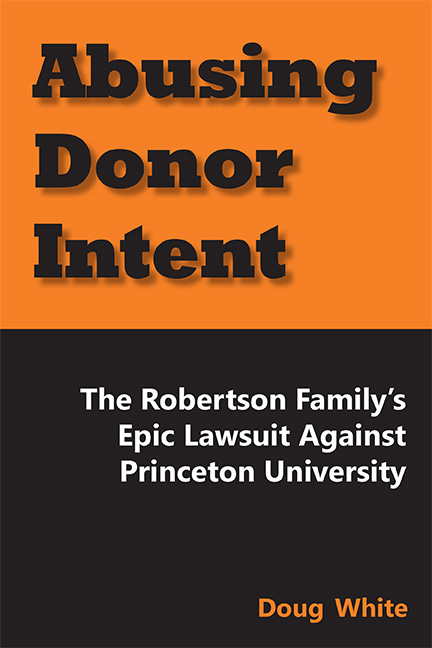


 An Extract
An Extract“Look at what this project could accomplish for the country.”
The words were whispered, although not intentionally, as Bill Robertson’s emotions emerged. The weight of some years – more likely, some decades, as he thought of it – was being lifted. He would finally be able to tell an immensely personal story that happened to be about the largest lawsuit in the history of philanthropy.
During a period of six and a half years, beginning in the summer of 2002, the actions of this man, whom most everyone would assume by his outward demeanor of gentleness and accommodation could do no harm, at first surprised, then irritated, then upset, then offended, then riled, and then, finally, exploded the sensitivities of those who work in the patrician atmosphere that permeates the charitable organization that is Princeton University.
From his perspective, his goal wasn’t to inflict damage. But he did think it was high time Princeton stopped inflicting its damage.
He wanted the voices of his parents to be heard. They had spoken through their enormous charitable gift forty years earlier, and their altruism was intended to accomplish something. Charles and Marie Robertson actually wrote it all down on a piece of paper, a carefully drawn, legally binding document hovered over by several attorneys – the family’s as well as the university’s – before it was declared satisfactory.
To the casual observer of Princeton’s world-renowned Woodrow Wilson School, things seemed to be going swimmingly. But by 2002, Robertson, who sat on the board of the foundation his parents created, had put up with enough. “The whole idea had gotten so off course,” he says, “it was time to pull the plug.”
He wanted nothing less than to remove the original money and all of its earnings from Princeton’s control and go elsewhere with it, not to benefit himself or any other individual, but to use it at another, more deserving university, one that would adhere more faithfully to his parents’ wishes. So, with his brother and two sisters, he went to court. The genteel environment of the boardroom would be replaced by the much more daunting rough and tumble venue of the legal system.
The arguments, the animosity and the money were about a basic idea: assuring that the dream of two people would become a reality. Like tens of millions of other donors – some wealthier, many far less wealthy – they wanted to do good things for the world, and they committed a sizable portion of their fortune and intellectual capital to make that happen.
This is a story about their children, led by Bill Robertson, who were determined to ensure, at whatever cost, that their parents’ intentions would live in perpetuity. The good people at Princeton say they were ensuring the Robertson legacy, but they may never have suspected, when disagreement on that point arose, that the children would be as resolute as they were.
It was the largest one-time amount – $35 million – anyone had ever donated to benefit a university. Charles and Marie Robertson were specific about the way the money was to be used. It was intended to help Princeton’s Woodrow Wilson School for Public Policy and International Affairs focus on sending its graduates into those areas of the federal government concerned with international relations. “But the university,” the son says, “was ignoring my parents’ intentions. ” Furthermore, he maintains, Princeton’s administrators were “harming the country as well.”
That’s not, as you might imagine, the way Princeton saw it – or sees it today. The people there say they not only assiduously honor the concept of donor intent for all its supporters, but that in this case they were particularly faithful to the donors’ intentions. “Princeton,” a top administrator once said, “ has always used the funds given by Marie Robertson solely for the purpose for which she made her $35 million gift in 1961.” The university contends that the Woodrow Wilson School has been and continues to be one of the best in the country for public administration and policy with an international orientation, and that it was unfairly disparaged.
By 2002, the corpus of the gift, even after annual expenditures were accounted for, had grown to almost $700 million, a sizable portion of Princeton’s endowment. By the spring of 2008, the fund had grown to $850 million. In part because of the sheer amount of money and in part because of Princeton’s prominence in American academia, the lawsuit, the longest and most debilitating litigation ever in the history of American philanthropy, was destined to draw scrutiny. Among nonprofit executives, board members, donors and students of philanthropy, it is the most discussed legal case relating to donor intent. As the lawsuit wended its way through the court, it was covered extensively in the media, not only in outlets that specialize in nonprofit news, but in the general-circulation media as well.
In addition to the sum of money at stake and the audacious, public challenge to a pillar of the most academically revered group of universities in the country, another, more important reason the world took note – and why all donors and all nonprofit organizations should never forget what happened – is that this dispute, at its heart, sharply raised the awareness of the need for trust and honor in the sector of our society that most demands and depends upon those qualities.
Princeton officials claim they fulfilled their obligations. The Robertson family claims Princeton made a mockery of them. No matter what the defendants might say, Robertson insists he wasn’t the bad guy; he was just trying to protect the family’s honor.